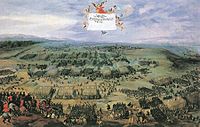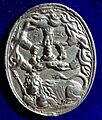Frederick V of the Palatinate facts for kids
Quick facts for kids Frederick V |
|
|---|---|
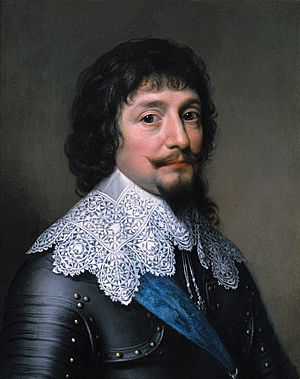
Portrait by Michiel Jansz. van Mierevelt, c. 1630
|
|
| Elector Palatine | |
| Reign | 19 September 1610 – 23 February 1623 |
| Predecessor | Frederick IV |
| Successor | Maximilian I |
| King of Bohemia (as Frederick I) | |
| Reign | 26 August 1619 – 8 November 1620 |
| Coronation | 4 November 1619 |
| Predecessor | Ferdinand II |
| Successor | Ferdinand II |
| Born | 26 August 1596 Deinschwang, Palatinate (present-day Lauterhofen, Germany) |
| Died | 29 November 1632 (aged 36) Mainz, Holy Roman Empire (present-day Germany) |
| Spouse | |
| Issue more... |
See
Henry Frederick, Electoral Prince of the Palatinate
Charles I Louis, Elector Palatine Elisabeth, Princess-Abbess of Herford Prince Rupert, Duke of Cumberland Prince Maurice Louise Hollandine, Abbess of Maubuisson Prince Louis Prince Edward, Count Palatine of Simmern Princess Henriette Marie Prince Philip Frederick Princess Charlotte Sophia, Electress of Hanover Prince Gustavus Adolphus |
| House | Palatine Simmern |
| Father | Frederick IV |
| Mother | Princess Louise Juliana of Orange-Nassau |
| Religion | Calvinist |
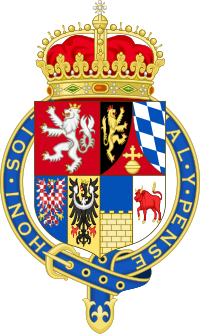
Frederick V (born August 26, 1596 – died November 29, 1632) was an important ruler in Europe. He was the Elector Palatine of the Rhine from 1610 to 1623. This was a powerful position in the Holy Roman Empire, which was a large group of lands in central Europe.
Frederick also became King of Bohemia for a short time, from 1619 to 1620. His time as king was so brief that people called him "the Winter King." This nickname meant his reign was like winter, short and quickly over.
Frederick was born in Deinschwang, which is now in Germany. His father was Frederick IV, Elector Palatine, and his mother was Countess Louise Juliana of Nassau. Frederick was a Calvinist, a type of Protestant Christian. He took over from his father as Elector Palatine in 1610. He was also known for building the beautiful Hortus Palatinus gardens in Heidelberg.
In 1618, a big war called the Thirty Years' War started. It began when Protestant nobles in Bohemia rebelled against their Catholic king, Ferdinand II, Holy Roman Emperor. They asked Frederick to become their new king. He accepted and was crowned King of Bohemia on November 4, 1619.
Frederick was chosen because he led the Protestant Union, a group of Protestant states. They hoped his father-in-law, James VI of Scotland and I of England, would help him. But James did not support Frederick's claim to Bohemia. Also, Frederick's allies in the Protestant Union did not send military help. His short rule as king ended when his army was defeated at the Battle of White Mountain on November 8, 1620. This was just a year and four days after he became king.
After this defeat, Frederick's own lands were invaded. He had to flee to the Dutch Republic in 1622. In 1623, he officially lost his title as Elector Palatine. He spent the rest of his life living in exile, mostly in The Hague, and died in Mainz in 1632.
Even though Frederick's reign was short, his family had a lasting impact. His son, Charles I Louis, Elector Palatine, got back some of the family's lands in 1648. Another son, Prince Rupert of the Rhine, became a famous military leader. Frederick's daughter, Princess Sophia, later became the heir to the British throne. She is the ancestor of the Hanoverian kings and queens of Britain.
Contents
- Early Life and Education (1596–1610)
- Becoming a Ruler: The Guardianship Dispute (1610–1614)
- Marriage to Elizabeth Stuart
- Frederick's Rule Before the Thirty Years' War (1614–1618)
- Becoming King of Bohemia (1619–1620)
- Loss of Frederick's Lands (1621–1622)
- Life in Exile (1622–1632)
- Death (1632)
- Family and Children
- Images for kids
- See also
Early Life and Education (1596–1610)
Frederick was born on August 26, 1596, in Deinschwang, Germany. His father, Frederick IV, Elector Palatine, ruled the Electoral Palatinate. His mother was Louise Juliana of Nassau, daughter of William I of Orange. Frederick was related to many royal families in the Holy Roman Empire.
The capital city, Heidelberg, had an outbreak of the bubonic plague. So, Frederick spent his first two years in another part of the Palatinate. In 1598, he moved to Heidelberg. In 1604, he went to live with his uncle, Henri de La Tour d'Auvergne, Duke of Bouillon, in Sedan, France.
While in Sedan, Frederick often visited the court of Henry IV of France. His teacher was Daniel Tilenus, a Calvinist theologian. Tilenus believed that Protestant rulers should unite and help other Protestants who were being treated unfairly. These ideas likely influenced Frederick's future decisions.
Becoming a Ruler: The Guardianship Dispute (1610–1614)
On September 19, 1610, Frederick's father, Frederick IV, passed away. Frederick V was only 14 years old at the time. According to the rules, his closest male relative should have been his guardian and ruled the Palatinate until Frederick was old enough.
However, Frederick's closest male relative, Wolfgang William, Count Palatine of Neuburg, was Catholic. So, before he died, Frederick IV chose another relative, John II, Count Palatine of Zweibrücken, as Frederick's guardian. Frederick V welcomed John to Heidelberg, but Wolfgang William was not allowed in.
This caused a big argument among the princes of the Holy Roman Empire. In 1613, the Emperor Matthias, Holy Roman Emperor stepped in. As a result, Frederick V was allowed to start ruling the Palatinate himself, even though he was still young. The dispute ended in 1614 when Frederick turned 18. However, this argument created lasting bad feelings among the ruling families.
Marriage to Elizabeth Stuart
Frederick V's father had planned marriages to strengthen the Palatinate's ties with other Protestant rulers. Following this plan, Frederick V wanted to marry Elizabeth Stuart. She was the daughter of James VI of Scotland and I of England, the King of England and Scotland.
King James had thought about marrying Elizabeth to the Catholic King of France, Louis XIII of France. But his advisors disagreed. Frederick's advisors worried that if Elizabeth married a Catholic, it would upset the balance between religions in Europe. So, they were determined that she should marry Frederick V.
A marriage agreement was signed on May 26, 1612. Frederick traveled to London to meet Elizabeth. They had already written letters to each other in French and got along well. They became officially engaged in January 1613. Their wedding took place on February 14, 1613, at the royal chapel in the Palace of Whitehall.
The wedding was a huge celebration with plays and performances. Frederick was also made a Knight of the Order of the Garter, a special honor. After the wedding, Frederick and Elizabeth traveled to The Hague to visit Frederick's uncle before returning to Heidelberg. They arrived in Heidelberg on June 12, 1613, to great celebrations. Elizabeth was very popular with Frederick's people. Their popularity grew even more when their first son, Frederick Henry, was born on January 1, 1614.
As part of the marriage deal, Frederick agreed to make Heidelberg Castle bigger. These changes were finished in 1615. A special entrance to the castle was named the "Elizabeth Entrance" in her honor.
Frederick's Rule Before the Thirty Years' War (1614–1618)

When Frederick started ruling, one of his first actions was to attend a meeting of the Protestant Union. There, he became very ill with a fever. After this, people said he seemed changed, sad, and possibly depressed. Because of this, Frederick gave much of his responsibilities to his main advisor, Christian I, Prince of Anhalt-Bernburg.
Frederick started many building projects to make his rule seem grand. Besides the castle renovations, he ordered the creation of a beautiful garden called the Hortus Palatinus. This garden was designed by famous architects. In the garden, Frederick was shown as a god, like Apollo or Hercules.
In terms of politics, Frederick wanted to be a leader for the Protestant princes in the Holy Roman Empire. He aimed to protect the freedom of German nobles against the Catholic Emperor Matthias, Holy Roman Emperor. The Empire had a delicate balance between Catholic, Lutheran, and Calvinist areas. Conflicts between these groups were growing into a big struggle over how the Empire should be run. Also, a break in the Eighty Years' War (a war between the Dutch and Spanish) was ending in 1621. This meant fighting would likely start again.
The Palatinate was in the middle of Germany, making it easy for imperial troops to invade. Unlike many other areas, the Electoral Palatinate was not one solid piece of land. It had two separate parts surrounded by other lands. The Lower Palatinate was around Heidelberg, and the Upper Palatinate was around Amberg. The Lower Palatinate was mostly farming land. The Upper Palatinate was a mining area and one of the richest parts of Europe.
Becoming King of Bohemia (1619–1620)
Why Frederick Became King
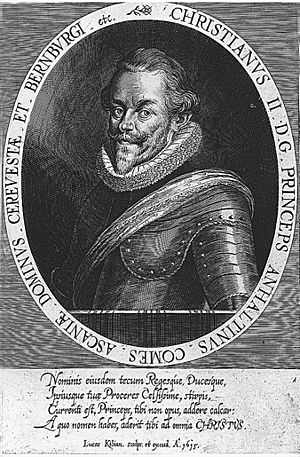
The Kingdom of Bohemia was a monarchy where the king was chosen by election. Since 1526, the kings of Bohemia had been from the House of Habsburg, who were also the Holy Roman Emperors. But in the early 1600s, Bohemia faced problems. The nobles in Bohemia worried that the Habsburgs wanted to take away their freedoms. Many Bohemian nobles were Protestant and feared a Catholic emperor would force them to become Catholic.
So, a strong group of nobles opposed Emperor Rudolf II. Rudolf had fought a long war against the Ottoman Empire. To get Bohemia's support, Rudolf promised to protect their religious liberty in 1609. This promise was called the Letter of Majesty. Still, the Bohemian nobles did not trust Rudolf and stayed in touch with the Protestant Union.
The Bohemian nobles later elected Matthias as their king in 1611. He became emperor in 1612. But in 1612, the Protestant Union discussed having a Protestant king for Bohemia. Frederick's name came up. Some thought if Frederick became king, it would make the Elector of Saxony join the Protestant cause. This idea turned out to be wrong.
The religious conflicts in Bohemia continued. In 1617, Matthias convinced the Bohemian nobles to elect Ferdinand, Duke of Styria, as the next king. Ferdinand was a very strong Catholic. Many Protestant nobles believed he would take away the protections of the Letter of Majesty. Their fears grew when Imperial officials ordered Protestants to stop building churches on certain lands.
On May 23, 1618, a group of Protestant nobles stormed Prague Castle. They threw two Imperial governors and their scribe out of a window. This event, known as the Second Defenestration of Prague, started the Bohemian Revolt. It also marked the beginning of the Thirty Years' War.
Frederick V's advisor, Christian I, Prince of Anhalt-Bernburg, wanted to help Bohemia. At first, he didn't suggest Frederick as king because Frederick was young and a Calvinist, while Bohemia had few Calvinists. Frederick himself was not eager to challenge the Emperor. However, he secretly blamed the Jesuits and the Spanish for the problems in Bohemia.
Frederick's name was first mentioned as a possible king in Prague in November 1618. Frederick's agents might have played a role in this. His diplomat, Christoph von Dohna, spoke to King James I of England about it, but James did not like the idea. The princes of the Protestant Union also rejected it, fearing a religious war.
Behind the scenes, Frederick allowed a force under Ernst von Mansfeld to help the Bohemian rebels. In August 1618, Mansfeld's forces entered Bohemia. They captured Pilsen on November 21, 1618, giving Protestants control of the kingdom.
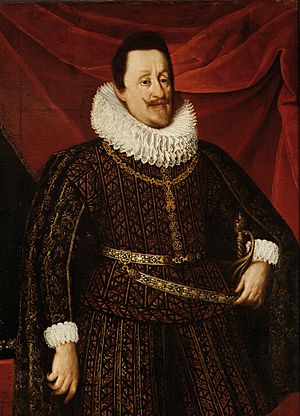
Emperor Matthias died on March 20, 1619. Although Ferdinand II had been crowned King of Bohemia before, the Bohemian nobles now refused to recognize him. Fearing an invasion, the nobles formed the Bohemian Confederacy on July 31, 1619. This group was against the Habsburgs, and Protestantism became the main religion in Bohemia. In August 1619, the Bohemian parliament declared that Ferdinand had lost his right to the throne. This meant war was unavoidable.
The Bohemians wanted the Elector of Saxony as their new king, but he refused. This left Frederick as the most important Protestant prince willing to take the risk. In August 1619, Frederick's chances of becoming king increased when Gabriel Bethlen started a revolt against the Habsburgs in Hungary.
Frederick in Prague
On August 26, 1619, the Bohemian Confederacy elected Frederick as their new king. Frederick heard the news on August 29. Two days later, Ferdinand II was elected Holy Roman Emperor. Frederick was the only elector who voted against Ferdinand. Even other Protestant electors supported Ferdinand. The electors also said that Bohemia's attempt to remove Ferdinand was wrong.
Historians have wondered why Frederick accepted the Bohemian crown. Some believed it was because his wife, Elizabeth Stuart, wanted to be a queen. More recently, historians think Frederick felt it was his duty to help his fellow Protestants. He also saw economic benefits, as the Upper Palatinate was a center for iron, and Bohemia was known for tin and glass. His advisor, Christian of Anhalt, told him that uniting these areas could be good for business.
On September 12, 1619, the Protestant Union met and told Frederick not to get involved in Bohemia. Other possible allies, like the Dutch Republic, said they could not help him if he accepted the offer. Only Gabriel Bethlen offered encouragement.
Between September 24 and 28, Frederick decided to accept the Bohemian crown. He said he would "not resist the will of the Almighty." The Dutch Republic, Venice, Denmark, and Sweden recognized Frederick as King of Bohemia.
On September 29, 1619, Frederick left Heidelberg for Prague. He traveled with many people and wagons. On October 31, 1619, Frederick entered Prague and was greeted with excitement.
Coronation and Reign
Frederick was crowned with the Crown of Saint Wenceslas in St. Vitus Cathedral on November 4, 1619. The coronation was led by a Protestant leader, not the Catholic Archbishop. The ceremony followed old traditions, with only small changes. Even though much of the country was suffering from war, the coronation was celebrated with grand parties.
Frederick became king of a weak country with many internal problems. The government's money was low, and Bohemian kings had little power to raise funds. They depended on the nobles and taxes. Protestant nobles felt higher taxes were needed for the war, but the country already felt burdened by past wars. Frederick also had to give gifts to his supporters to keep them loyal.
In Prague, Frederick soon upset some nobles and clergy. Neither Frederick nor his wife spoke Czech. So, many court jobs went to foreigners, while local nobles managed their areas. This made it hard for the royal family to connect with the local people.
Frederick V's court preacher, Abraham Scultetus, caused more problems. He wanted to spread Calvinism in Bohemia. The local churches had kept religious images, but Scultetus started destroying them. On December 21, 1619, images were removed from St. Vitus Cathedral. On December 27–28, a famous painting of the Virgin Mary was destroyed. There were even rumors that the grave of St. Wenceslaus would be ruined. Scultetus' actions were very unpopular. Frederick tried to distance himself, saying his orders were not being followed.
The nickname "The Winter King" appeared soon after Frederick became king. A pamphlet in 1619 first used the term. Frederick's supporters tried to fight back, saying he was a "Winter Lion" who protected Bohemia. They said he would also be a "Summer Lion," meaning his rule would last.
Meanwhile, Ferdinand II gathered his forces. On October 21, 1619, he made a deal with Maximilian, Duke of Bavaria, leader of the Catholic League. This deal made Maximilian commander of the forces against Frederick. It also promised Maximilian control of Bohemia and Frederick's electoral title. The Emperor also got support from the Elector of Saxony.
Frederick's advisor, Christian of Anhalt, urged Frederick to call a meeting of Protestant princes. This meeting in December 1619 was a failure. Few princes sent representatives, and the Elector of Saxony refused. Those who came only half-heartedly promised to protect Frederick's lands in the Rhineland while he was in Bohemia.
In March 1620, Frederick sent a legal defense of his actions. He argued that he had not broken any imperial laws because Bohemia was outside the Holy Roman Empire. Therefore, he said, it was not a conflict between an imperial prince and the emperor. Frederick argued that Ferdinand could not use imperial power against him. However, a meeting of imperial leaders, including the Elector of Saxony and Maximilian of Bavaria, rejected Frederick's argument. They said Bohemia was part of the Empire.
On April 1, 1620, the imperial side gave Frederick an ultimatum. They told him to leave Bohemia by June 1. If he didn't, Ferdinand threatened to use his power as Emperor to overthrow him.
Soon after, the Elector of Saxony signed a treaty with Ferdinand. In this treaty, Ferdinand promised to allow Lutheranism in Bohemia. He also agreed to give the Elector of Saxony control of Lusatia.
This was the situation when the Bohemian Confederacy parliament met on March 25, 1620. Frederick asked for huge tax increases and a draft to fight the coming imperial threat. To raise money, Frederick used his own funds and pawned his jewels. In May 1620, he even moved two tons of gold to Bohemia, causing the Palatinate to go bankrupt.
Bad news kept coming for Frederick. King James I of England refused to send military help. The Netherlands sent only a small force and a limited amount of money. Worst of all, on July 3, 1620, the Protestant Union signed the Treaty of Ulm (1620). This agreement meant they would no longer support Frederick and would stay neutral in the conflict.
The Battle of White Mountain (November 8, 1620)
After the Treaty of Ulm was signed, Imperial troops began to gather. In early August 1620, 25,000 troops marched towards Bohemia. But then they changed direction and invaded the nearly unprotected Electoral Palatinate, Frederick's homeland. The Palatinate was defended by only 2,000 English volunteers and was easily taken. Imperial troops set up camps in Frankenthal and Mannheim. From Bohemia, Frederick could do nothing to stop the invasion of his home.
After capturing Linz, Maximilian, Duke of Bavaria, crossed into Bohemia on September 26, 1620. At Rokycany, Maximilian's forces met Frederick's army. Frederick had managed to gather 15,000 poorly paid and equipped troops. Frederick visited his army on September 28, but he was not a military leader. He left the fighting to his generals. Frederick focused on getting supplies and preparing defenses.
After some small fights, Frederick's forces retreated towards Prague on November 5, 1620. Imperial troops followed them. On November 7, Bohemian forces decided to make a stand at White Mountain, just outside Prague. The day before, King Frederick had ridden along the lines to encourage his soldiers. He then rushed to Prague to ask the Bohemian nobles for more money for his troops and to meet with English envoys.
However, it was too late. On November 8, 1620, when Frederick wanted to ride back to his troops, he was met at the gates of Prague by his fleeing soldiers. His advisor, Anhalt, told him the terrible news: the Bohemian army had been completely defeated that morning in the Battle of White Mountain.
Escape and Exile
Anhalt told Frederick there was only one choice: immediate escape. So, on November 9, Frederick fled to Breslau, the capital of Silesia. He took his wife, child, some advisors, and the Bohemian Crown Jewels.
Maximilian took Prague shortly after Frederick left. From Silesia, Frederick wanted to plan revenge for the Battle of White Mountain. But the Silesian nobles refused to help him. He was forced to leave Silesia in early 1621.

Writers at the time, both Catholic and Protestant, made fun of Frederick's escape. After his Order of the Garter was found in Prague, pamphlets often showed him with his stockings falling down.
On January 21, 1621, Ferdinand issued a decree against Frederick. He accused Frederick of breaking the peace and treason. Ferdinand declared that Frederick's lands and titles in the Holy Roman Empire were now lost. On February 6, 1621, representatives of the Protestant Union met with Ferdinand to protest. But they soon agreed to support the new situation in the Palatinate, which was occupied by Spanish troops. At this point, the Protestant Union basically stopped existing.
The Twelve Years' Truce, a break in the war, ended on April 9, 1621. On April 14, Frederick joined his wife in The Hague. The Dutch Republic and Frederick signed a contract. He accepted their support to try and win back his lands.
In Bohemia, the defeat of the Bohemian Revolt had terrible results. Twenty-eight Bohemian nobles were executed on June 21, 1621. The heads of twelve nobles were nailed to the Old Town Tower of Charles Bridge, where they stayed for ten years. The election of kings was ended. The power of the nobles was greatly reduced. Ferdinand himself tore up the Letter of Majesty. Only Lutheranism was allowed in Bohemia, and in the following years, most people were forced to become Catholic again. Bohemia remained part of the Habsburg monarchy until 1918.
Loss of Frederick's Lands (1621–1622)
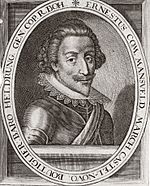
In the summer of 1621, John II, Count Palatine of Zweibrücken, Frederick's former guardian, stepped down. He had been ruling the Electoral Palatinate while Frederick was in Prague.
However, Ernst von Mansfeld still held part of the Upper Palatinate. He had successfully fought off attacks by Johann Tserclaes, Count of Tilly. Mansfeld moved into the Rhineland Palatinate in early 1622, and Frederick joined him there on April 21, 1622. Frederick tried to convince other Protestant princes to restart the Protestant Union, but he had little success.
Frederick's cause got a boost with a victory over Tilly's forces at the Battle of Wiesloch on April 27, 1622. But this boost did not last long. Frederick's forces were defeated at the Battle of Wimpfen on May 6, 1622. Then, his forces were soundly defeated at the Battle of Höchst on June 20, 1622.
Frederick was increasingly under Mansfeld's influence and was losing hope in the Protestant cause. With Frederick's knowledge, Mansfeld raided Darmstadt and captured Louis V, Landgrave of Hesse-Darmstadt and his son as hostages. This was a clear violation of imperial law and made Frederick lose any remaining sympathy he had in Europe. During his retreat, Mansfeld burned a city and thirty villages.
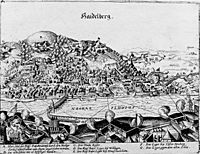
Frederick dismissed Mansfeld when he realized he could not win back his lands. Frederick then spent the summer with his uncle in Sedan.
Soon after, troops under Tilly and Gonzalo Fernández de Córdoba completed the Spanish conquest of the Electoral Palatinate. After an eleven-week siege, Heidelberg fell on September 19, 1622. Mannheim fell on November 5, 1622. Only the British soldiers in Frankenthal still held out. After Heidelberg was captured, Protestant churches were closed, and the university was shut down. The famous library, the Bibliotheca Palatina, was given as a gift to Pope Gregory XV.
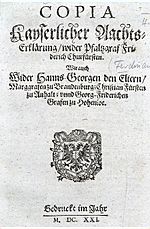
On February 23, 1623, Ferdinand II, Holy Roman Emperor gave Frederick's electoral title to Maximilian of Bavaria. Maximilian also received the conquered territory of Upper Palatinate. Other parts of the Electoral Palatinate were given to Wolfgang William, Count Palatine of Neuburg.
Life in Exile (1622–1632)
In late 1622 and early 1623, Frederick set up a Palatinate government-in-exile in The Hague. This council was led by Ludwig Camerarius.
There were attempts to make peace between Frederick and the emperor in 1624–25 and in 1627, but nothing came of them. Frederick was willing to compromise, but he wanted his lands and electoral title back. The emperor was not willing to give them back. Frederick hoped his lands might be won back by force. But these hopes were crushed on August 27, 1626, when the forces of Christian IV of Denmark were defeated at the Battle of Lutter.
Frederick left most of the daily work of his government-in-exile to his advisors. He did take some interest in his money. Frederick was very careful with funding his administration. However, to keep up the appearance of a royal court, he spent huge amounts on building and entertainment. He quickly used up donations from the English and Dutch governments. For example, in 1629, Frederick ordered a large summer palace to be built in Rhenen, called the 'Koningshuis'. When it was finished in 1631, this palace had a large main building and gardens. Frederick spent much of his time there hunting and taking long walks.
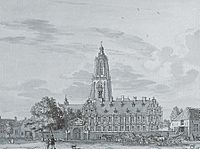
Frederick suffered a personal tragedy on January 17, 1629. He was traveling to Amsterdam to see the Spanish treasure fleet captured by the Dutch. His boat overturned while crossing a body of water. Frederick survived, but his eldest son, 15-year-old Frederick Henry of the Palatinate, drowned. Frederick himself was seriously injured and took 15 months to fully recover.
At a meeting in 1630, Frederick formally asked for forgiveness for accepting the Bohemian crown. But nothing came of it. In March 1631, Frederick sent a diplomat to discuss getting his lands back. But Frederick died before these talks could lead to anything.
Death (1632)
On July 4, 1630, Gustavus Adolphus of Sweden joined the Thirty Years' War. On September 16, 1631, Gustavus Adolphus' forces defeated Tilly's forces. Tilly was defeated again the next year, and Gustavus Adolphus' forces moved into southern Germany. When Oppenheim was captured in December 1631, Frederick thought it was time to return to the Palatinate. He left for Heidelberg.
In February 1632, Frederick met Gustavus Adolphus in Frankfurt. Gustavus Adolphus treated Frederick with full royal honors. However, Gustavus Adolphus was not ready to help Frederick get his lands back. England and the Netherlands had not agreed to such a plan.
Frederick then joined Gustavus Adolphus' march into Bavaria. He was present when they marched into Munich on May 17, 1632. When Frederick pressed his case, Gustavus Adolphus told him he would only help if Frederick agreed to hold the Palatinate as a territory belonging to the King of Sweden. The Palatinate lands were too important strategically for Gustavus Adolphus to just give them back to Frederick. Gustavus Adolphus also insisted that Frederick allow equal rights for Lutherans in his territories. Frederick refused these conditions, and they parted ways. Frederick traveled to Swedish-occupied Mainz, planning to return to The Hague.
Gustavus Adolphus was killed at the Battle of Lützen (1632) on November 16, 1632. Around this time, the English finally decided to send troops to the Thirty Years' War. Unfortunately for Frederick, it was too late. Starting in October 1632, he suffered from an infection that worsened. A famous doctor was called, but nothing could be done. Frederick died on the morning of November 29, 1632, from a "pestilential fever."
Frederick's son and heir, Charles Louis, was only 15 years old. So, Frederick's brother, Louis Philip, Count Palatine of Simmern-Kaiserslautern, served as regent. Frederick's internal organs were buried in Oppenheim. His embalmed body was taken to Frankenthal. On June 9, 1635, with Spanish troops approaching, his brother fled with Frederick's body. It is believed that Frederick's body was moved to Sedan in September 1637, but his final resting place is unknown.
Family and Children
Frederick V married Elizabeth Stuart, daughter of James VI of Scotland and I of England. They were married on February 14, 1613, and had the following children:
- Frederick Henry (1614–1629)—drowned.
- Charles Louis (1617–1680), became Elector Palatine in 1648.
- Elisabeth (1618–1680).
- Rupert (1619–1682), famous from the English Civil War.
- Maurice (1620–1652), also served in the English Civil War.
- Louise Hollandine (1622–1709).
- Louis (1623–1624), died as a baby.
- Edward (1625–1663).
- Henriette Marie (1626–1651).
- Philip Frederick (1627–1650).
- Charlotte (1628–1631).
- Sophia (1630–1714), who became the heir to the thrones of England and Ireland. She married Ernest Augustus, Elector of Hanover. Her son became King George I of Great Britain in 1714.
- Gustavus (1632–1641), died young from epilepsy.
Images for kids
-
Map showing the Electoral Palatinate in the Holy Roman Empire. As son and heir of Frederick IV, Elector Palatine (1574–1610), Frederick was the hereditary ruler of the Palatinate.
-
Elizabeth Stuart (1596–1662), 1613.
-
Frederick V on horseback with Prague in the background.
See also
 In Spanish: Federico V del Palatinado para niños
In Spanish: Federico V del Palatinado para niños




